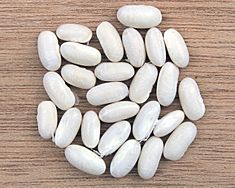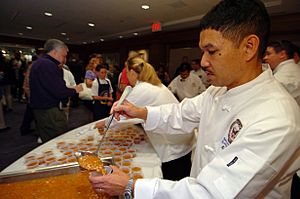Navy bean facts for kids
Quick facts for kids Navy Bean |
|
|---|---|
| Species | Phaseolus vulgaris |
 |
|
| Nutritional value per 100 g (3.5 oz) | |
|---|---|
| Energy | 1,468 kJ (351 kcal) |
|
60.75 g
|
|
| Sugars | 3.88 g |
| Dietary fiber | 24.4 g |
|
1.5 g
|
|
|
Protein
|
22.33 g
|
| †Percentages estimated using US recommendations for adults. | |
The navy bean is a small, oval-shaped white bean. It's also called a haricot, pearl haricot bean, Boston bean, white pea bean, or pea bean. This bean first grew in the Americas. People use navy beans in many yummy dishes. You can find them in baked beans, different soups, and even pies!
Navy bean plants can grow in two ways. Some grow like a bush, staying small and compact. Others are vining types, meaning they climb and spread out. The way they grow depends on their specific type, called a cultivar.
Other kinds of white beans include cannellini beans, 'Great Northern' beans, and lima beans (also known as "butter beans"). There are also runner beans.
Contents
The name "Navy bean" comes from America. The U.S. Navy has given these beans to its sailors for a long time. They have been a common food for sailors since the mid-1800s.
In Australia, people started growing navy beans during World War II. It was important to find cheap and healthy food for the many soldiers there. Many American troops were based in Queensland. The U.S. military encouraged farmers to plant a lot of these beans. Today, Kingaroy in Australia is known as the "Baked Bean Capital." During the war, some people also called them "Yankee beans."
There are several types, or cultivars, of navy beans. Each type might have slightly different features.
Some well-known navy bean types are:
- 'Rainy River'
- 'Robust': This type can fight off the bean common mosaic virus. This virus can spread through seeds.
- 'Michelite': This type came from 'Robust'. It grows more beans and has better seed quality.
- 'Sanilac': This was the first navy bean type that grew like a bush.
Other White Beans You Might Know
Besides navy beans, there are other popular white beans:
- Cannellini beans: These are also called white kidney beans. They are popular in central and southern Italy. Cannellini beans are bigger than navy beans. They are related to the red kidney bean. Like red kidney beans, they have higher levels of a natural substance called phytohaemagglutinin. People often use them in minestrone soups.
- 'Great Northern': These are sometimes called "large white" beans. They are bigger than navy beans but smaller than cannellini beans. They have a flat shape, a bit like lima beans. Great Northern beans have a mild flavor.
- Runner beans: In Greece, large white beans from the runner bean plant are called gígantes (meaning "giants") and eléfantes (meaning "elephants"). The scientific name for the runner bean is Phaseolus coccineus.
- Marrow bean: This is a medium to large white bean. It has a taste that some people describe as bacon-like. Marrow beans were very popular for baked beans in the U.S. in the 1800s and early 1900s.
White beans are a great plant-based source of something called phosphatidylserine (PS). They also have high levels of apigenin, about 452 to 192 micrograms per kilogram. The amount of apigenin can be different in various legumes.
Eating baked beans can help lower your total cholesterol. It can also reduce "bad" cholesterol, known as low-density lipoprotein cholesterol. This might be because navy beans have a lot of saponin. Saponins can also fight against bacteria and fungi. They have even been found to slow down the growth of some cancer cells. Plus, navy beans are full of ferulic acid and p-coumaric acid. They have more of these than other common bean types.
Dried and canned beans stay fresh for a long time. Keep them in a pantry or another cool, dark place. The temperature should be below 75 degrees Fahrenheit (24 degrees Celsius). If you store seeds properly, they can last one to four years for replanting. For cooking, well-kept seeds can last almost forever! Try to avoid beans that are discolored. They should be pure white. If they are not, it might mean they were not handled well when they were dried.
See also
 In Spanish: Frijol blanco para niños
In Spanish: Frijol blanco para niños


